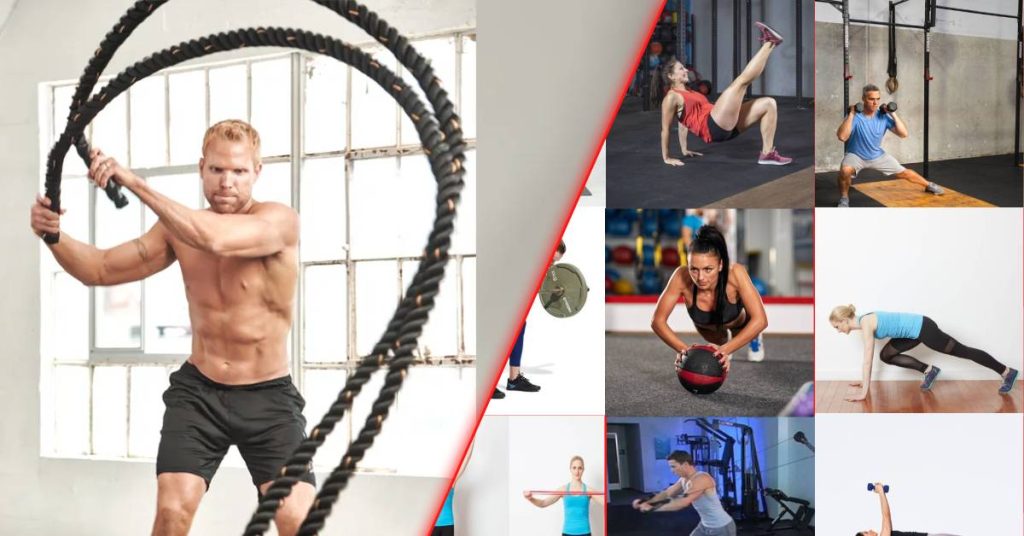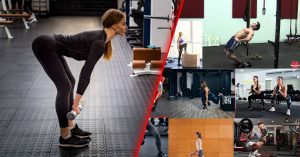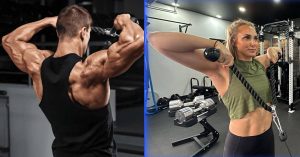Did you know that combining upper body strength with cardio can double your workout efficiency? Yes, you heard it right! However, in today’s fast-paced world, squeezing in time for a lengthy workout session seems nearly impossible for most of us. That’s where the “upper body cardio exercises” comes into play, acting as a game-changer for those on a tight schedule.
Imagine getting the best of both worlds—strength and endurance—packed into a quick, under 30-minute routine. Intrigued? This guide is about to take your fitness game to a whole new level with upper body cardio exercises that promise not just effectiveness but supreme efficiency.
But what makes these exercises so special, and how can they fit into your busy life? Read on as we unveil the details of the upper body cardio circuit workouts.
Table of contents
MORE keyboard_double_arrow_down LESS keyboard_double_arrow_up
The Importance of Combining Cardio Exercises With Strength Training
The fitness realm has long been dominated by a clear divide: cardio exercises for burning calories and improving endurance, and weight lifting for building strength and muscle. Yet, this traditional separation overlooks the potential of combining these two powerhouses into a single, dynamic workout.
Enter the era of cardio upper body exercises, a revolutionary approach that shakes up the fitness world by merging the calorie-torching benefits of cardio with the muscle-building prowess of strength training. But what’s the science behind this, and why does it work so well?
The Power of Combination
Integrating upper body cardio exercises into your routine does more than just save time; it creates a synergistic effect that enhances both your cardiovascular health and muscular strength. Here’s why this combo is a knockout:
- Efficiency in Action: By targeting your upper body muscles while keeping your heart rate up, you’re essentially doubling down on your workout benefits.
- Boosted Metabolism: Cardiovascular activities increase your heart rate, leading to more calories burned. When you add the resistance of upper body exercises, your body works harder, pushing your metabolism into overdrive.
- Enhanced Endurance and Strength: It’s common to think of endurance and strength as separate entities, but when fused together through cardio exercises using upper body only they elevate your physical capabilities to a level you might not have thought possible.
So, this innovative workout strategy is more than just a time-saver; it challenges and breaks down the traditional barriers within the fitness industry. By combining cardio and strength training, it proves that you don’t need to confine your workouts to one category to achieve remarkable results.
The Convenience Factor
One of the most appealing aspects of upper body cardio exercises is their inherent convenience. Whether you’re a busy professional, a student juggling deadlines, or simply someone who prefers short, effective workouts, this routine fits seamlessly into your lifestyle. But how can you start incorporating these exercises into your own routine?
- No Special Equipment Needed: Many upper body cardio exercises can be done with minimal or no equipment, making them accessible to everyone.
- Anywhere, Anytime: Forget about the hassle of going to the gym. These workouts can be performed in the comfort of your home, in a park, or even in a small hotel room while traveling.
The Best Upper Body Cardio Exercises
If you’re short on time for lengthy workouts but still want to tone your upper body, try this quick cardio circuit workout. It only takes about 30 minutes and focuses on strengthening your chest, back, shoulders, and arms.
Each exercise in this routine involves movements that work multiple parts of your body, which also helps to get your heart pumping. This means you’ll burn more fat and calories while doing the exercises. The workout moves fast, so you’ll accomplish a lot in a short amount of time.
To do this workout, you’ll need some dumbbells of different weights, a barbell, a resistance band, a weighted medicine ball, and a step or platform. You’ll also want a timer, like the one on your phone or fitness watch, to keep track of how long each session lasts.
Mountain Climbers

Mountain climbers are more than just an exercise; they’re a dynamic way to kickstart your circuit. When you ramp up the pace, you’re not only boosting your heart rate but also engaging your core, arms, and legs in a full-body workout. The beauty of mountain climbers lies in their simplicity and effectiveness.
Here’s how to do it:
- Begin in a pushup position on the floor.
- Alternate bringing your knees towards your chest, mimicking a running motion.
- Aim to move as fast as possible while maintaining proper form.
- Repeat this movement for 60 seconds.
To make it more challenging, iIncrease your pace. As you speed up, you’ll notice your core engaging more intensely.
Med Ball Push Ups

Introducing a medicine ball into your push-ups introduces instability, forcing your muscles to work harder to maintain balance. This added challenge engages more muscle groups, especially your core, enhancing the exercise’s overall effectiveness.
But the real magic happens when you start switching the medicine ball from one hand to the other. This not only tests your coordination and balance but also keeps your muscles guessing, leading to improved strength and endurance over time.
Here’s how to do it:
- Begin in a pushup position, with options for beginners to lower their knees to the floor and for intermediate to advanced exercisers to be elevated on their hands and toes.
- Place a medicine ball under one hand.
- Lower your body into a pushup, then push back up.
- While pushing back up, roll the medicine ball across the floor to the other hand and place it underneath.
- Repeat this process, alternating the side of the medicine ball with each pushup.
- Do as many repetitions as possible within 60 seconds.
No medicine ball? No problem! Simply perform push ups without using the medicine ball.
Front Lunge With Chest Press
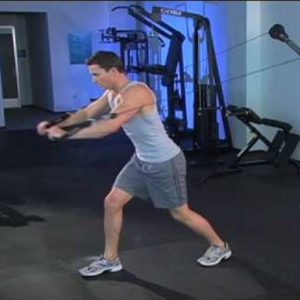
When you combine a front lunge with a chest press, you’re doing more than just working out your legs and chest. You’re creating a compound movement that requires coordination and balance, engaging multiple muscle groups simultaneously.
Adding a resistance band to this exercise amplifies the benefits, introducing an element of resistance that your body must work against. This not only strengthens your chest and leg muscles but also challenges your core and stability.
Here’s how to do it:
- Start by standing with a resistance band anchored behind you at chest height.
- Take a step forward into a lunge position while simultaneously pressing one arm forward as if performing a chest press.
- Return to the starting position by stepping back.
- Repeat this movement 20 times, alternating sides with each lunge.
No resistance band available? Just do lunges without the band to maintain an elevated heart rate.
Jumping Jacks With Lat Pulls

Jumping jacks are a staple in cardio routines, known for their simplicity and effectiveness in getting your heart rate up. But when you add a resistance band to the mix, the exercise takes on a new dimension. The resistance band forces your latissimus dorsi (the broadest muscles of the back) to engage more intensely as you pull the band apart.
This not only works your back differently but also ensures that a simple cardio exercise now tones and strengthens your upper body.
Here’s how to do it:
- Hold a resistance band in both hands overhead.
- Get ready to do jumping jacks.
- As you jump your feet out, simultaneously bring your arms down and wide, spreading them out to your sides.
- Feel your back muscles, especially the latissimus dorsi, engaging as you do this.
- Jump your feet back together and return your arms overhead.
- Repeat this sequence for 60 seconds.
No resistance band available? Just skip this exercise, or you can use a towel or a jumping rope as an alternative.
Barbell Bent-Over Row

The barbell bent-over row is a testament to the power of form and precision. It’s an exercise that targets the muscles in your back, arms, and shoulders.
The key to reaping the benefits of this exercise while protecting your back lies in maintaining a strong, stable core and a neutral spine throughout the movement. This engages not just the target muscles but also involves the core, enhancing posture and strength.
Here’s how to do it:
- Stand with your feet hip-distance apart and your knees slightly bent.
- Hold a barbell with your hands shoulder-width apart, relaxed below your shoulders.
- Bend forward at the hips until your upper body is parallel to the floor.
- Keep your abs engaged and aim to maintain a long and flat back.
- With your upper back muscles engaged, pull the barbell towards your chest.
- Lower the barbell and repeat this movement.
- Keep your abs tight and bend your knees as needed to support your lower back.
- Repeat this exercise 15 times.
No barbell available? Simply do this exercise while holding a dumbbell in each hand.
Side Lunge With Arm Row
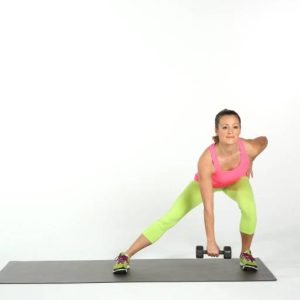
At first glance, a side lunge might seem like a lower-body exercise. However, when combined with an arm row, it evolves into a dynamic, full-body workout. This combination not only strengthens your legs but also targets your upper back, biceps, and shoulders.
The catch? It requires coordination and balance to synchronize the lunge with the arm row, challenging your body in multiple ways.
Here’s how to do it:
- Start by standing with your feet hip-width apart.
- Hold a dumbbell in each hand, arms resting at your sides.
- Take a big step to the right, moving into a side lunge position.
- As you lunge, pull the weights up in a rowing motion, ending at chest level.
- Step your right foot back to meet the left while lowering your arms back to the starting position.
- Repeat this movement 20 times, alternating sides with each lunge.
Begin with medium-weight dumbbells and gradually increase to heavier ones as you progress.
Side Squat With a Shoulder Press

The side squat with a shoulder press is a brilliant example of how combining movements can lead to greater fitness benefits. This exercise not only improves lower body strength and flexibility but also builds power in the shoulders and arms.
The act of squatting engages the glutes and quads, while the shoulder press works the deltoids and triceps.
Here’s how to do it:
- Start standing with your feet hip-width apart.
- Hold a dumbbell in each hand and lift your arms to shoulder level, forming a “goal post” shape with your elbows in line with your shoulders and palms facing forward.
- Take a wide step out to the right into a squat position while maintaining the “goal post” position with your arms.
- As you step your right foot back to center, press the dumbbells overhead.
- Lower the weights as you step out to the left into a squat, then press the weights overhead again as you bring your legs back to center.
- Repeat this sequence for 20 reps, alternating sides with each step.
Squat With Iron Cross
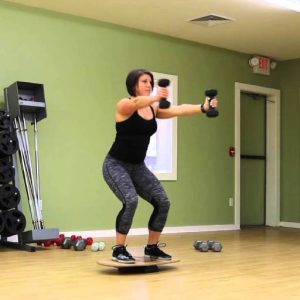
The squat with an iron cross is a dynamic move that challenges your entire body in a unique way. As you squat, extending your arms to the sides with weights engages not only the lower body but also the shoulders, chest, and back.
This exercise enhances coordination and balance while promoting muscular endurance and strength across multiple muscle groups. But what makes it so effective in transforming your overall workout?
Each of these exercises contributes to a well-rounded upper body cardio workout by integrating strength training into cardiovascular routines. The incorporation of resistance bands, weights, and precision in movement ensures that you’re not just going through the motions but actively enhancing your strength, endurance, and overall fitness.
Here’s how to do it:
- Begin standing with your feet hip-width apart.
- Hold a dumbbell in each hand with your arms extended in front of your chest, palms facing each other.
- Extend your arms out to the sides, keeping your elbows soft but extended, creating a T shape with your body.
- Hinge at the hips and lower your body into a squat position.
- As you lower your hips, return your arms to the front of your chest with palms facing each other.
- Return to standing position, and extend your arms back out to the T position.
- Repeat this movement, opening and closing your arms with each squat.
- Do this exercise 15 times.
Over-the-Step Biceps Curl
The over-the-step biceps curl introduces a dynamic element to the traditional biceps curl by incorporating movement over a step or bench.
This not only activates the biceps through the curl but also engages the core and improves balance as you step over. The act of stepping adds a cardiovascular component to what is traditionally a strength-focused exercise.
Here’s how to do it:
- Stand beside a step or platform, placing your right foot on top of it.
- Hold one dumbbell in each hand, arms extended down at your sides, palms facing front.
- Step over the platform to the right while simultaneously performing a biceps curl.
- Once on the other side of the platform with your left foot ready to step over, continue the movement by stepping over and completing another biceps curl.
- Keep repeating this motion, stepping over the platform and doing biceps curls with each repetition.
- Continue for 60 seconds.
Hammer Curl With Power Squat
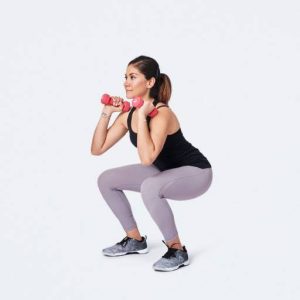
Combining a hammer curl with a power squat creates a full-body workout that surpasses the benefits of traditional squats. This exercise targets the biceps and lower body simultaneously, enhancing muscular coordination and balance.
The integration of the hammer curl adds an upper body strength component, making this a multi-functional exercise.
Here’s how to do it:
- Start standing with your feet hip-width apart.
- Hold a heavy weight in each hand, with your palms facing inward towards your body.
- Lower your body into a squat position while simultaneously pushing the weights forward into a hammer curl.
- Keep your palms facing inward and your elbows close to your torso throughout the movement.
- Stand up as you lower the weights back down to the starting position.
- Repeat this sequence for 12 repetitions.
Triceps Dips With Leg Extensions
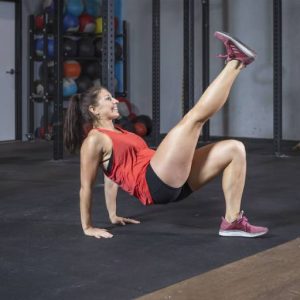
Triceps dips with leg extensions take the traditional triceps dip to a new level by incorporating a leg extension with each dip. This variation not only strengthens the triceps but also engages the core and challenges the quadriceps.
The key to maximizing its effects lies in the simultaneous engagement of upper and lower body muscles, promoting functional fitness and muscle endurance.
Here’s how to do it:
- Sit on a step or chair, keeping your hands close to your hips.
- Slide your hips off the surface so you have to support your weight with your arms.
- Extend your right leg, lifting the foot off the floor.
- Bend your elbows to lower your body a few inches, then press back up.
- Return to the starting position, then switch legs and repeat the movement.
- Alternate sides for 30 to 60 seconds.
Rear Lunge With Double Arm Row
The rear lunge with a double arm row is a compound exercise that targets the legs, back, and biceps. This movement not only improves lower body strength and stability but also enhances upper body muscle tone and posture.
The double arm row, performed during the lunge, increases the engagement of the back and arms, providing a comprehensive workout.
Here’s how to do it:
- Hold medium-heavy weights in each hand.
- Step back with your right leg into a straight-leg lunge.
- Tip forward from the hips while keeping your back flat.
- Pull the elbows up in a double arm row.
- Lower the weights, step back to the starting position, and repeat for 16 reps on each leg.
To increase intensity, lift the back leg at the same time you pull the weights up.
Knee With Side Kick
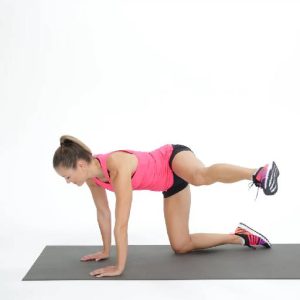
Adding a side kick to a knee raise introduces an element of martial arts to your workout, making it more engaging and fun. This exercise improves balance, flexibility, and strength by targeting the core, legs, and glutes.
The key to perfecting it lies in the control and precision of the movement, ensuring that both the kick and the knee raise are performed with proper form.
Here’s how to do it:
- Lift your left knee up and out to the side while simultaneously bringing your left elbow down, squeezing your obliques.
- Step down with your left foot and kick out with your right.
- Repeat this sequence for 30 seconds and then switch sides.
Be cautious not to hyperextend your knee when kicking out. Keep a slight bend in your knee as you kick.
Weighted Snatch and Swing
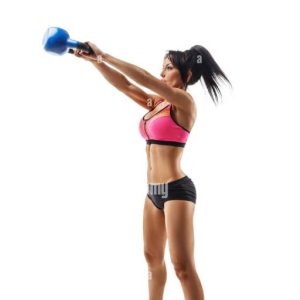
The weighted snatch and swing is a challenging exercise that tests and improves your power, strength, and endurance. This movement targets a wide range of muscle groups, including the shoulders, back, glutes, and hamstrings.
The explosive nature of the snatch combined with the controlled swing sculpts the body and boosts metabolic rate.
Here’s how to do it:
- Stand with one foot slightly in front of the other in a staggered stance.
- Hold a heavy weight in your right hand.
- Swing the weight back and then straight up over the shoulder.
- Pause at the top and slowly lower the weight down for 4 counts.
- Repeat this movement for 12 reps on each side.
Focus on a quick push up and a controlled return to the original stance. By bringing the weights down with control, you’ll isolate and work the bicep and shoulder muscles.
Barbell Curls – Crazy 8’s
The “Crazy 8’s” take the conventional barbell curl and turn it into a high-intensity workout that stands out from the standard routine. This variation consists of three sets: 8 reps of half curls from the bottom to the midpoint, 8 reps from the midpoint to the top, and finally, 8 full-range curls.
This method ensures that the biceps are under constant tension throughout different ranges of motion, which can lead to increased muscle strength and endurance.
Here’s how to do it:
- Grip the barbell with hands shoulder-width apart.
- Lift the barbell halfway up.
- Lower it and repeat for 8 reps.
- Next, raise the barbell to its full height.
- Lower it only halfway down for another set of 8 reps.
- Finish with 8 full-range repetitions.
- Begin with a lighter barbell weight.
- Gradually increase the weight as you gain confidence and strength.
Triceps Circuit – Ice Breakers
“Ice Breakers” introduce an explosive element to triceps workouts, designed to conclude your routine with a burst of high-intensity effort. This circuit may involve a series of triceps-focused exercises performed back-to-back with minimal rest, incorporating movements that require both power and precision.
The secret behind its effectiveness lies in the combination of dynamic movements that stimulate the triceps muscles from various angles, promoting muscle growth and endurance.
Here’s how to do it:
- Start in a squat position.
- Jump into the air, circling the right arm around and down into a chop as you land.
- Jump again, this time chopping down with the left arm.
- Alternate sides with each jump for 60 seconds.
For a lower-impact option skip the jump and start in a squat position and stand up while performing the hand chop motion.
Triceps Extensions
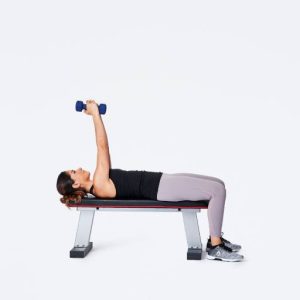
Mastering the triceps extension is crucial for targeting the triceps muscles effectively. Whether performed standing or lying down, the key to perfecting this exercise is ensuring your elbows stay in place while only your forearms move.
This isolation allows for targeted stress on the triceps, leading to better muscle definition and strength.
Here’s how to do it:
- Lie on a bench or the floor.
- Hold weights straight up over the shoulders, palms facing each other.
- Bend the elbows and lower the weights towards the ears.
- Press back up and repeat for 16 reps.
Tips for an Efficient Upper Body Cardio Circuit
Embarking on your fitness journey with a solid foundation is essential. A proper warm-up primes your body for the workout ahead, increasing blood flow to your muscles and reducing the risk of injury. But what exactly should your warm-up look like? Simple cardio activities like jogging in place or doing jumping jacks for 5-10 minutes can set the stage.
However, the real game-changer comes from seamlessly transitioning between exercises without breaks. This continuous movement challenges your stamina and keeps your heart rate elevated.
Yet, the beauty of this workout lies in its flexibility. You have the power to tailor the intensity and number of circuits to fit your personal fitness level. And let’s not forget the importance of choosing the right weights. Opting for weights that are challenging but manageable ensures you push your limits without compromising form.
Expert Insights on Upper Body Cardio Exercises
Fitness experts universally acknowledge the blend of cardio with strength training as the cornerstone of a holistic fitness regimen.
This combination not only enhances cardiovascular health but also builds muscular strength, offering a double-edged sword against physical stagnation. However, striking the perfect balance between the two can seem like walking a tightrope.
Here are some direct insights from experts in the field:
- Dr. Sarah Johnson, Exercise Physiologist: “Integrating upper body cardio circuits into workouts presents a unique opportunity to target multiple muscle groups simultaneously while elevating heart rate. This leads to efficient calorie burn and improved endurance. However, it’s crucial to ensure proper form and technique to avoid overuse injuries, especially in the shoulders and elbows.”
- Coach Michael Rodriguez, Certified Personal Trainer: “Upper body cardio circuits are fantastic for those aiming to enhance functional strength and endurance. By incorporating exercises like push-ups, burpees, and boxing drills, individuals engage not only their upper body muscles but also their core and stabilizer muscles. It’s essential to progressively increase the intensity and vary exercises to prevent plateaus and keep the body challenged.”
- Nutritionist Rachel Chen, MS, RD: “When implementing upper body cardio circuits into a fitness routine, it’s imperative to consider nutrition and hydration. These high-intensity workouts demand adequate fueling, particularly with a focus on carbohydrates for energy and protein for muscle repair and recovery. Hydration is also key to maintaining performance and preventing fatigue, especially during longer circuit sessions.”
In summary, upper body cardio circuits offer a potent blend of cardiovascular and strength benefits, but they require careful attention to technique, progression, nutrition, injury prevention, and psychological readiness. By incorporating insights from various experts, you can optimize these workouts for maximal effectiveness and long-term success in their fitness journey.
Key Takeaways and Final Thoughts
In conclusion, upper body cardio exercises offer a revolutionary approach to fitness, combining the efficiency of cardiovascular workouts with the muscle-building benefits of strength training. By seamlessly integrating these exercises into a dynamic circuit routine, you can achieve remarkable results in a short amount of time.
The convenience factor, minimal equipment requirements, and ability to tailor workouts to personal fitness levels make upper body cardio circuits accessible to all. However, it’s essential to prioritize proper form, progression, nutrition, hydration, and injury prevention to maximize the effectiveness and long-term success of these workouts.
With insights from fitness experts, you can harness the power of upper body cardio exercises to transform your fitness and achieve holistic health goals.
Key Points
- Incorporating upper body strength exercises with cardio elements can significantly enhance workout efficiency, allowing for both muscular and cardiovascular improvements within a shorter timeframe.
- The workout is scalable to suit beginners through advanced exercisers, emphasizing the importance of adjusting weights and intensity according to individual fitness levels for optimal safety and effectiveness.
- While certain exercises suggest using gym equipment like dumbbells, barbells, and resistance bands, alternatives and modifications are available to accommodate those with limited access to equipment, making the workout accessible to everyone.
- This regimen offers a comprehensive approach to fitness by not only improving muscle strength and definition but also boosting cardiovascular health, endurance, and overall metabolic rate.
- Maintaining correct form during exercises is crucial to prevent injuries and ensure that the targeted muscles are effectively engaged, maximizing the benefits of each movement.
- Fitness experts advocate for the integration of cardio and strength training, highlighting the combined approach as key to achieving a balanced and effective fitness routine.
FAQs
Can beginners attempt an upper body cardio circuit workout?
Yes, beginners can definitely attempt this workout. It’s designed to be scalable, meaning you can adjust the intensity and weights according to your fitness level. Start with lighter weights (or no weights at all) and fewer repetitions, gradually increasing as you become more comfortable and stronger.
How often should I perform the upper body cardio circuit workout?
For optimal results, aim to incorporate this workout into your routine 2-3 times a week. This allows for adequate recovery time between sessions while ensuring you’re consistently challenging your muscles and cardiovascular system.
Do I need any special equipment for these workouts?
While some exercises suggest using equipment like dumbbells, barbells, and resistance bands, many movements can be modified to use body weight only or household items as alternatives. The key is to focus on form and technique to effectively engage the target muscle groups.
What are the main benefits of combining cardio with strength training in an upper body workout?
Combining cardio with strength training offers several benefits, including improved cardiovascular health, increased muscle strength and endurance, enhanced metabolic rate for better fat burning, and greater overall fitness. This holistic approach ensures you’re not only building muscle but also improving heart health and endurance.
How can I ensure I’m maintaining proper form during the workout?
To maintain proper form, start by watching demonstrations of each exercise, either through the interactive guide mentioned or by consulting fitness professionals. Always perform movements in front of a mirror when possible to self-monitor your form. Additionally, keep movements controlled, focusing on engaging the correct muscle groups, and don’t rush through the exercises. If in doubt, consider hiring a personal trainer for personalized guidance, at least in the initial stages.
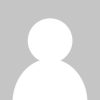
ABOUT THE AUTHOR
Follow Valen Steven for a dose of fitness enthusiasm, evidence-based advice, and a roadmap to achieving your health and wellness goals.
Subscribe to our Newsletter
Dive into a world of fitness and wellness with our exclusive newsletter! Sign up now and receive weekly power-packs of fitness wisdom

